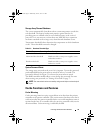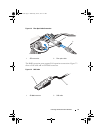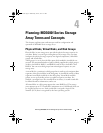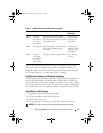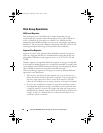
Planning: MD3600f Series Storage Array Terms and Concepts 43
RAID Levels
RAID levels determine the way in which data is written to physical disks.
Different RAID levels provide different levels of accessibility, redundancy,
and capacity.
Using multiple physical disks has the following advantages over using a single
physical disk:
• Placing data on multiple physical disks (striping) allows input/output (I/O)
operations to occur simultaneously and improve performance.
• Storing redundant data on multiple physical disks using mirroring or parity
supports reconstruction of lost data if an error occurs, even if that error is
the failure of a physical disk.
Each RAID level provides different performance and protection. You should
select a RAID level based on the type of application, access, fault tolerance,
and data you are storing.
The storage array supports RAID levels 0, 1, 5, 6, and 10. The maximum
number of physical disks that can be used in a disk group depends on the
RAID level:
• 96 for RAID 0, 1 and 10
• 30 for RAID 5 and 6.
RAID Level Usage
To ensure best performance, you should select an optimal RAID level when
you create a system physical disk. The optimal RAID level for your disk array
depends on:
• Number of physical disks in the disk array
• Capacity of the physical disks in the disk array
• Need for redundant access to the data (fault tolerance)
• Disk performance requirements
book.book Page 43 Wednesday, June 8, 2011 5:01 PM



